|
John Galt
and the Canada Co.
The Library’s
archival, rare, and special collections section can be reached by taking the
single elevator or stairs in the south-east corner (past the
Circulation/Reserve area) to the lower level where researchers can use
materials in the Wellington County Room.
TRELLIS,
the TriUniversity Libraries catalogue, is the primary tool for identifying
and locating materials in Archival and Special Collections. TRELLIS
can be accessed through the Library’s home page
(http://www.lib.uoguelph.ca), where various web resources are also
available.
HISTORY
John Galt (1779-1839) composed a number of
novels of Scottish life, travelled widely, and helped settle land in the
Canada Company tract in Upper Canada (1826-29). The collection was
established in 1975 as a fitting tribute to the founder of Guelph, and has
been expanded whenever suitable material has been available. The library
collections had already contained some Canada Company material and this also
has been augmented as material became available.
DESCRIPTION
The John Galt Collection includes almost
all published works by John Galt, including many rare and first editions.
The library is attempting to acquire copies of every variant edition
(including American pirated editions) in the original issue state. The
H.B.Timothy Collection consists of printed and manuscript materials on
John Galt and his descendants; the research materials of Jennie Aberdein, an
early biographer of John Galt; and an early two-hundred page draft
manuscript of a biography of Sir Walter Scott by John Galt. The Lizars
Collection contains six original John Galt letters (his son, John Galt,
married a Lizars) and many letters by other family members, especially Sir
Alexander T. Galt, and his son Elliot Torrance Galt. Other archival
collections contain examples of original Canada Company land deeds and
circulating holdings contain many books, pamphlets, and maps connected with
the Canada Company.
LANGUAGE
English predominates. Original works by Galt are
collected in any language (only French and German are known), and critical
material in any language is collected on Galt or the Canada Company.
HOLDINGS
More than 300 books, pamphlets and theses are
held by or about John Galt. The Canada Company holdings consist of 60 titles
of printed material. The archives have 2 linear meters of material on the
Galts in the H.B.Timothy Collection, and an additional 5 linear cm. on Galt
consisting of original letters and manuscripts. The Canada Company material
consists of 13 linear cm. of papers including charters, minutes of
agreements, correspondence, and legal documents. A new web site has been
created for this collection.
BIBLIOGRAPHIC ACCESS
All titles are catalogued and access is via the
library’s online catalogue, Trellis. LC classification is used and archival
collections as well as government documents are coded
PHYSICAL ACCESS
The collection is open to the public. The hours
of opening for the library are normally 7:00 a.m.-2:00 a.m. with exceptions
posted. Rare and archival collections are open Monday-Friday, 8:30 a.m.-4:45
p.m. (4:30 p.m. in summer).
Interlibrary Loan:
Available except for rare and archival
materials.
Reprography:
Yes, as the condition of the material warrants,
and as the copyright allows.
Reference Assistance:
Yes.
PUBLICATIONS DESCRIBING COLLECTION
No present publication describes the entire
collection. However, the following publications describe parts of it:
Stelter, Gilbert A. -- "The John Galt letters in
the Lizars Collection". --Collection update. - No. 7 (May 1983). --
[Guelph, Ont.]: University of Guelph Library, 1983.
Sauer, Tim. -- "Bibliographic comments on John
Galt". -- Collection update. -- No. 7 (May 1983). [Guelph, Ont.]:
University of Guelph Library, 1983.
Cunliffe, Vera. -- From Edinburgh to Colborne
Township: Daniel Lizars and the Pioneer Collection at Guelph. -- Guelph,
Ont.: University of Guelph Library, 1984.
SELECTIONS
John Galt, Lawrie Todd
(1832) rare
books s0417b21
John Galt, The Provost
(1822) rare
books s0417b30
John Galt, Ayrshire Legatees
(1823) rare
books s0417b06
John Galt, The Entail
(1823) rare
books s0417b12
John Galt, Unpublished manuscript – Walter
Scott (1837) archives XR1 MS A277053
John Galt, The Member
(1832) rare
books s0555b03
John Galt, Voyages and Travels and Letters
from the Levant (1812) rare books s0415b09
Canada Company, Charter of Incorporation
rare books s0531b07
Jennie W. Aberdein, Research notes,
1924-1965 archives XR! MS A277012
Galt's
Literary Career
Any
discussion of rare editions of John Galt’s books must begin with some
attempt to define his literary output from a bibliographical point of view,
since more than half of the forty odd books which he wrote were not
reprinted in the nineteenth century, and many of them have still not been
reprinted.
Although
John Galt is primarily known for his novels written in West Country Scottish
dialect, his writing was exceedingly varied. He wrote biography,
autobiography, historical fiction, history, poetry, drama, travelogues,
travel and emigrant guidebooks and short stories of all sorts on a wide
variety of topics. These appeared in periodical publications of the day and
in book form, school books, childrens books, as well as the novels which he
characterized as “theoretical histories” such as the Annals of the parish,
The Provost, etc. Given the economic necessity for Galt to write, and
the variation in editorial control exerted by the many publishers he used,
the literary quality of much of what he wrote is not the best. Thus, despite
the fact that it is a bibliographer’s tragedy that some of his juvenile
literature (eg. Gog and Mogog) has not survived, their disappearance
is not likely that significant from a literary perspective. However, some of
his works deserve a better fate than the one or two early printings which
have never been repeated, effectively causing them to be unavailable to the
reading public for approximately one hundred and fifty years.
Galt’s
literary production may be divided, for present purposes, into four time
periods as follows: his early period prior to his relationship with William
Blackwood (begun in mid 1819, although effectively not starting until 1820
or 1821); the productive years from 1820 to 1826; the treadmill years from
1829 to late 1832 or early 1833; and finally, the later period after his
first stroke in October 1832 until his death in April 1839. Although
somewhat a generalization, the first editions of his works during the second
period are the most sought after and desirable from a collector’s point of
view, as they represent his commonly known titles; while the works published
during the first and last period are the rarest and most difficult to
obtain. This article will limit itself to the two middle periods, from 1820
to late 1832, and subsequent articles will deal with the other periods.
Galt's
Productive Years
It is
significant that scarcity of an edition cannot be equated with value or
desirability from a collector’s point of view. In the case of Galt’s work
published from 1820 to 1832, most of them were immediately reprinted in the
United States as soon as the boat arrived with the English edition, for this
was the height of the American “pirate” editions. The print runs were
generally the same 1500 copies (although some of Galt’s Blackwood titles had
a first print run of 2000), the paper was of a similar quality, although
there were more typesetting errors, and the three volume novels were
generally issued in two volumes. For a variety of reasons they are far
scarcer than the first English editions. With the exception of Lawrie
Todd, the library owns only one of the twenty odd American editions of
the period, and it is not recorded in Lumsden or Mansell. However, they are
generally not Considered as collectable or valuable as the first English
editions.
Galt’s
productive period from 1820 to 1826 is the time when all of his popular
novels were published, with the exception of Lawrie Todd (1830), one
of the few books by Galt which had a lasting popularity in the United
States. John Galt’s reputation as an author has primarily rested on the West
Country Scottish novels published during this period (Annals of the
parish, 1821; Ayshire legatees, 1821; Sir Andrew Wylie
1822; The Provost, 1822; The entail, 1822; and the Last of
the lairds, 1826) all of which were published by William Blackwood.
With a few exceptions these were the only Galt novels which were kept in
print throughout the nineteenth and twentieth Centuries. During 1841-43, the
young Blackwoods assembled all the Galt copyrights owned by their firm and
D.M. Moir edited these works into four volumes of Blackwood’s Standard
Novels. These were reprinted several times throughout the nineteenth century
from the 1841-43 plates.
In 1895
D.S. Meldrum edited an eight volume Collection entitled “the Works of John
Galt” which Consisted of these Blackwood Standard Novels. In 1936 Meldrum
and W. Roughead edited a ten volume edition of the works which was simply
the 1895 edition re-edited with the addition of Ringan Gilhaize.
In the
twentieth Century Foulis Press reprinted three of the novels and two
collections. They began with Annals of the parish in 1910 (PR 4708
G2 A8 i9lOA) and reprinted in 1911, 1912 and 1919 (PR 4708 G2 A8). This was
followed by The Provost in 1913 (PR 4708 G2 P7) and the Last of
the lairds in 1926 (PR 4708 G2 L28 1926). W. Roughead edited two
collections of short stories published by Foulis; The Howdie and other
tales, in 1923 (PR 4708 G2 H6) and A rich man and other stories
in 1925 (PR 4708 G2 R5). These printings are all in the very attractive
style typical of Foulis Press, bound in brown or red-brown buckram, and the
three novels have coloured lithographic plates by H.W. Kerr or J.M. Aitken,
tipped in. These are the most attractive editions and until Scottish
Academic Press began to reprint some of Galt’s works in the 1970’s, the
Foulis Press editions were the most readable.
Publications by Oliver & Boyd
Notwithstanding the literary merits of these Scottish novels published by
Blackwood, the 1820-26 period saw the publication of a number of books by
Oliver & Boyd which, although more unevenly written than the Blackwood
titles, have enough merit that they should have been reprinted oftener than
they have been. The only novel from this group to be reprinted consistently
was Ringan Gilhaize. This novel of the two century struggle of the
Church of Scotland for independence was Galt’s most carefully researched
novel. He visited all the locations mentioned in the book which he was not
familiar with, read extensively on the history of the period and carefully
planned his narrative technique. The care may well have been due to the fact
that Galt wrote it as a rebuttal to Scott’s unsympathetic portrayal of the
Covenanters in Old Mortality (1816). Although it has some technical
weaknesses, mainly the covering of a period of over 130 years through the
autobiography of the hero’s grandfather, its success as a non romantic
believable historical novel is best demonstrated by one factor which it
shared with The Provost, Annals and Legatees namely,
that Galt had to insist that it was indeed fiction.
The next
Oliver & Boyd title published was The Spaewife, a tale of the Scottish
chronicles (3 vols. 1823). Beyond the American pirate edition (2 vols.,
Philadelphia, Carey & Lea, 1824), it has only been reprinted once, probably
in the 1880’s in an inferior one volume edition printed in Galt’s birthplace
of Irvine. Set during the life and reign of James I of Scotland, it is one
of Galt’s more successful attempts to treat a favourite topic; the
supernatural, or what we would today call the para-psychologicaL Although
inferior to Ringan Gilhaize in that it is too romantic and less
creditable in places, the characterization of Anniple of Dunbiane, the
Spaewife, and of Glenfruin, are very well drawn. Glenfruin is a most
memorable Highland chieftain, portrayed as a coarse and older, yet pawkie
Andrew Wylie, whose repeated “Sowils and podies! — oomph!” must be
remembered by all who read the novel.
The library
has the first edition in the original boards as issued, with untrimmed
edges. It also has a copy of the Irvine printing (PR 4708 G2 S62) which is
probably scarcer than the first edition.
Rothelan
The last
novel published by Oliver & Boyd was Rothelan; a romance of the English
histories (3 vols, 1824), which except for the American edition (2 vols;
New York, Coffins & Hannay, 1825), has never been reprinted. It is
significant only to demonstrate Galt’s need to have a publisher who would
force him to write well. George Boyd basically published whatever Galt sent
him, and there was a steady deterioration in each successive work Galt
produced, which reached its lowest point in The bachelor’s wife,
published before Rothelan in 1824. This is a collection of short
stories best described as pot-boilers. On the other hand, Galt had
difficulties with the confining Presbyterian Tory publisher Blackwood, who
forced him to write very well, but who stifled his more liberal, often
earthy, yet very insightful writings. This is best exemplified by the
disappointing original publication of The last of the lairds as
compared to the far superior first edition of Galt’s original unexpurgated
manuscript as edited by Ian A. Gordon and published by Scottish Academic
Press in 1976 (PR 4708 G2 L2).
The
library’s copy of the first edition of Rothelan is in the original
boards with untrimmed edges, as issued. Our copy of The bachelor’s wife
is half bound in brown calf and marbled boards, with raised bands and gold
lettering and marbled edges to make a very attractive volume.
The
Treadmill Years
The period
after Galt’s return from Canada in May 1829 was followed by diligent writing
in order to free himself from debtor’s prison where he was from July 15 to
November 10. Much of his activity was spent in writing articles for
Blackwood’s magazine, but when it came to novels he was forced by
financial considerations to turn to Colburn and Bentley. They published
Lawrie Todd (3 vols., 1830); Southennan (3 vols., 1830); The
life of Lord Byron (1 vol., 1830) which went through three editions in
the same year; Bogle Corbet (3 vols., 1831); The Lives of the
players (2 vols., 1831); and Stanley Buxton; or, the schoolfellows
(3 vols., 1832). A final novel, Eben Erskine; or, the traveller, was
published in 1833 by their successor, Richard Bentley.
In 1832,
Galt, thoroughly exhausted by the three volume treadmill of Colburn and
Bentley, turned to yet another publisher, James Fraser, who published two
one volume novels, The Member; an autobiography, and The Radical:
an autobiography, both in 1832. As they did not sell, the remaining
stock was bound together and reissued as The Reform: being the Member and
the Radical, in 1833.
The Library
has copies of the first editions of all the Colburn and Bentley works in the
Rare Book room. Of the James Fraser imprints, the library recently acquired
a copy of The Radical bound in quarter brown leather and marbled
boards with gold lettering. The first edition is the only edition of this
book ever published. There was not even an American pirate edition produced,
Probably because Fraser was such a poor publisher from a marketing
perspective, that his books never reached America.
Of the
Colburn and Bentley imprints the library’s copies of Lawrie Todd,
Southennan and Eben Erskine are worth mentioning. The first
edition of Lawrie Todd is recently bound in a contemporary style of
half blue calf and light blue buckram, with raised band and gold tooling.
The second edition (Colburn & Bentley, 1830) has the three volumes bound in
half brown calf and brown buckram with gold lettering but no tooling. The
one volume revised and corrected edition of 1832 is a contemporary binding
in half blue calf and marbled boards with gold tooling and lettering. The
library’s copy of Southennan is in the original blue boards and brown
buckram spine with paper label as issued, and all volumes are still tight.
Our copy of Eben Erskine is half bound in brown calf with marbled
boards, raised bands and gold lettering with the armorial bookplate of Henry
Fowler Broadwood on the inside of the front cover of each volume.
Of the
books of this period, comments will be limited to three: Lawrie Todd,
Stanley Buxton and The Member.
Lawrie
Todd
Lawrie
Todd was the first book which Galt produced after returning from Canada.
Based on a manuscript autobiography of a New York seedsman, Grant Thorburn,
which Galt had purchased in the United States, it is the tale of yet another
“pawkie” Young Scot who goes out into the world and makes his fortune, this
time in the backwoods of upstate New York. It was a very successful book
from the point of view of sales, being reprinted many times in the next
twenty years. Some of the later American editions were edited and published
by Grant Thorburn, of which the library has an 1847 imprint called the
sixteenth edition. After Galt’s stroke, he had the manuscript autobiography
published by Fraser in December, 1834, with an introduction Written by
himself. Published under the title, Forty years’ residence in America;
or, the doctrine of a particular providence exemplified in the life of Grant
Thorburn (the original Lawrie Todd) seedsman, New York a of the two
titles shows that Galt took most of the volume one of Lawrie Todd
almost word for word from the Thorburn autobiography. It may be of interest
to note that the Thorburn firm was still in the seed business in New York at
the turn of the century, as the library has seed catalogues from 1898 from
J.M. Thorburn & Co. and 1905 from S.M. Thorburn & Co. The library also has a
copy of the autobiography bound in a contemporary green cloth with a leaf
design in the cloth, with untrimmed pages in very good condition.
At the
other extreme from Lawrie Todd in terms of contemporary popularity
and critical comment is Stanley Buxton; or, the schoolfellows, which
has never been reprinted except for the American editions of the next year.
Contemporary reviews were at least respectful. Thackeray called it “very
clever though rather dull - Mr. Galt knows the world or seems to know it
very well.” A romantic novel centering around the hero’s disinheritance, it
is a mixture of Scottish school boys, ghosts, changeling child, Victorian
romance and London tenement and business life. Although written as a
commissioned piece of writing, it is certainly worth a read, and deserves to
be reprinted, even if only by one of the reprint houses, to make it more
available to libraries.
Galt's
The Member and The Radical
In a
category by themselves are the two novels The Member and The
Radical. Through the accident of being published by a periodical
publisher who wanted to get into the book business, but didn’t know much
about book marketing and distribution, these two one volume works have been
the most sadly neglected of Galt’s works. Neither work was reprinted in the
United States, and while Ian Gordon edited a reissue of The Member in
1975 by Scottish Academic Press, The Radical is only obtainable in
the first edition or as The Reform, which was issued in 1833 from the
left over sheets of The Member and The Radical. The Member
has been called the first English political novel. Galt had always been
concerned with power, as shown in The Provost, Sir Andrew Wylie,
and more directly in the years he spent in London as a Parliamentary
lobbyist. Written in late 1831, with talk of political reform on everyone’s
tongue, its publication in January 1832 presents an ironic, humorous and
revealing picture of the old House of Commons just before the passage of the
1832 Reform Bill. The hero, Archibald Jobbry, recently returned from India,
decides to buy a seat in Parliament “to benefit kith and kin”. His two
election campaigns, his manipulating of ministers to serve his own ends, and
his decision to withdraw from politics just before the redistribution of
seats in the Reform Bill, are all written in a style reminiscent of Provost
Pawkie. Not a bad man, not self-deceiving, but a shrewd politician who plays
the game to his own advantage by the rules of the time, Jobbry differs from
Pawkie in that he does not try to change the process as the Provost does,
which is understandable given his increased sphere of operations. The other
difference is what makes The Member a political novel; the setting is
no longer the home and family which are not even mentioned, rather it is the
political milieu in which Jobbry operates.
Summary
Thus,
through an accident in the choice of a publisher, one of Galt’s best novels
has been ignored for over one hundred and forty years. It is significant
because of the generally held view that Galt ceased to produce anything of
real literary quality after he left for Canada in 1826. While the quality
after his return was generally far poorer, certainly The Member, and
to a somewhat lesser extent The Radical, are worthy of higher
critical examination And as we shall see when we look at the period after
Galt’s stroke in a subsequent issue, which is generally ignored from a
literary perspective, except for his two autobiographical works, John Galt
continued to write well until his death.
TIM
SAUER
THE JOHN
GALT LETTERS IN THE LIZARS COLLECTION
John Galt’s
place as a major nineteenth century novelist was well established with books
such as The Ayrshire legatees (1820) and Annals of the parish
(1821). His role as colonizer and town builder in Canada is still not as
well known, perhaps because his correspondence relating to Canada in the
late 1820s is scattered widely and only became available to scholars
comparatively recently. The two major collections necessary for a study of
Galt’s role in Canada are both in Canada. The massive collection of Canada
Company papers in the Ontario Archives in Toronto contains the large number
of official letters between Galt and the company’s Directors in London and
is essential for an understanding of Galt’s administrative duties as
Superintendent of the company’s Canadian operations. The Galt Collection in
the Public Archives of Canada in Ottawa is now quite extensive for the PAC
has recently acquired copies of letters previously in private hands. This
collection contains a good deal of correspondence between Galt and
professional friends in Scotland such as Dr. David Moir. In Britain,
considerable material relating to Galt appears in collections such as the
Bathurst Papers in the British Museum in London, the Dalhousie Papers at the
Scottish Record Office, Edinburgh, and the Piggott Papers at the Bodleian
Library, Oxford. H.B. Timothy has made extensive use of these collections
for his book The Galts: a Canadian odyssey: John Galt, 1779-1839
(Toronto, 1977) but Timothy was not particularly interested in Galt as a
town planner and builder.
The
recently acquired collection of Galt Correspondence in the Lizars Collection
at the University of Guelph Library Archival Collections is extremely modest
in size compared with the major Galt holdings elsewhere. It includes six
letters written by Galt between 1779 and 1839 — two to his aunt, Mrs. Elspa
Spirling and four to his cousin, Jeannie Spirling. It also includes two
letters by his younger brother, Thomas, to Mrs. Spirling. But these letters
were completely unknown to scholars before the purchase of the Lizars
material and they provide us with an insight into Galt’s character usually
not possible in his more guarded correspondence with business or
professional acquaintances.
In these
letters we see a young man’s dreams and disappointments, his initial
reaction to the immensity of London, his constant fear of letting down his
family who helped him financially, and his boyish thrill at finally
achieving success in Canada. Although he was born in Irvine, one of.
Scotland’s leading western seaports, his family moved to Greenock in 1789
and it was here, when he was sixteen, that Galt entered the Greenock Customs
House as a clerk to be trained for a career in business. At the age of
twenty-five he decided to make his fortune in London. In a letter to his
cousin Jeannie back in Irvine Galt graphically described his awestruck
response to the great metropolis.
. . . its size is beyond the mind of an
individual to comprehend which renders it beyond description. In some parts
it exalts my expectations, the effect of the whole however is not
remarkable. In my opinion its dimensions are its greatest magnificence and
these seem almost to partake of the infmite as they reach on every side
beyond the power of the eye.1
Galt’s
business career in London can only be characterized as a series of setbacks
and failures. His first venture was as a factor and broker together with a
partner, a certain McLachlan, from his part of Scotland. This business soon
failed and Galt reported to his aunt that McLachlan was returning to
Scotland to try to recover his health. Galt was excited, however, by the
arrival of his brother Thomas, who
. . . has at last come to Babylon and we are
concerting measures to regain the favour of the fickle cow, Fortune. For
some time our expectations must necessarily be very moderate,
notwithstanding I trust we shall creep onward to something in the end.2
Thomas was
also somewhat guarded about his prospects “in the Great City, in the land of
the Sons of Bull”.3 In a letter to Mrs. Spirling he
admitted he was inclined,
. . . to think unfavourably of many of our
Countrymen . . . but really I have met with so much illiberality, and
Selfishness, amongst them, that I confess, I look for Something better where
I am going - it is not improbable however I may be disappointed, but you
know our Motto - “Hope and Try.”
The
partnership between the Galt brothers was shortlived for the adventurous
Thomas left for the Honduras in 1809 where he died five years later. John
himself set off for a tour of Europe which resulted in the volume Voyages
and travels in 1812. His marriage in 1813 and his father-in-law’s
support did not give him financial security, for various business schemes
failed. As a result he and his family left London for Greenock and later
they moved to Musselburgh, a village near Edinburgh. Despite his financial
woes and constant wanderings, he produced some of his best books between
1820 and 1823 and also became active as a lobbyist at Parliament on behalf
of Upper Canadians claiming compensation for property losses during the War
of 1812. It was this Canadian connection which led to his great colonization
experiment through the formation of the Canada Company. Financial problems
continued to plague him during the complex negotiations prior to going to
Canada. He was not able to attend his mother’s funeral and hoped that she
might have had some satisfaction from knowing that his prospects finally
appeared to be brightening.
Several
months after the founding of Guelph, Galt believed that his fortunes had
definitely improved. In a long letter to his cousin, he spelled out his
feeling of relief.
It has pleased God at last after many
disappointments to place me in a situation to redeem some of my debts, and
although my office requires me to keep almost an open house I shall yet have
something if spared health to lay aside for kindness besides what is set
apart for the payment of what I owe.5
It was
extremely important to him that his family realize that he had succeeded
beyond his wildest dreams. He was particularly thankful that his
. . . good and ever anxious mother, before the
collapse of her last illness had some glimpse of the turn which my uncertain
fortunes were then taking. . . on the very day on which your letter was
written I was presiding at a festival given to the settlers in the new city
which I have founded and which is prospering beyond all expectation. It is
now a considerable town. When I think of the circumstances in which I am now
found I sometimes recall the fond predictions of poor Wally and your
affectionate mother. What would have been their exultation could I have told
them that I was placed in the situation of being the second person in this
great country with a lordly income and a power which in its administration
already affects the happiness of thousands and will probably influence the
destiny of their descendants for ages to come.
Galt’s
estimation of his status was certainly overblown; provincial officials would
have been dismayed to know that he considered himself next to the Lieutenant
Governor in importance in Upper Canada. Ironically, Galt left Guelph in
despair about sixteen months after writing this positive letter to his
cousin. His administration of company affairs was questioned by the
Directors who unceremoniously dismissed him from his position. He was to
continue to suffer financial problems until his death a decade later. But
his accomplishments in Upper Canada were nevertheless real and long lasting
and influence the lives of Guelph’s residents to this day. The small group
of letters in the Lizars Collection enables us to better understand the
motivations for his activities here.
I John Galt to Jeannie Spirling, July
4, 1804, Galt Correspondence, Lizars Collection, University of Guelph
Library, Archival Collections.
2
Ibid., John Galt to Mrs. Elspa Spirling, Oct. 6, 1808.
3
Ibid., Thomas Galt to Mrs. Spirling, Sept. 23, 1808.
4
John Galt to his sister, Dec. 12, 1825, Galt Papers, Public Archives of
Canada.
5
John Galt to Jeannie Spirling, Nov. 28, 1827, Lizars Collection.
GILBERT A.
STELTER
LIZARS FAMILY COLLECTION
The Library’s archival, rare, and special
collections section can be reached by taking the single elevator or stairs
in the south-east corner (past the Circulation/Reserve area) to the lower
level where researchers can use materials in the Wellington County Room.
TRELLIS, the
TriUniversity Libraries catalogue, is the primary tool for identifying and
locating materials in Archival and Special Collections. TRELLIS can
be accessed via the public terminals through the Library home page (http://www.lib.uoguelph.ca),
where various web resources are also available.
HISTORY
The collection was begun with
the purchase in 1982 of the bulk of the Lizars family library. Daniel Lizars
was a printer and publisher who emigrated to Upper Canada in 1833 and
settled in Goderich. He brought with him, or subsequently had sent out, a
substantial library of over seven hundred books, many of which are connected
with the Lizars family as printers, engravers, publishers, etc. Since 1982,
the library has acquired all material with any Lizars family connection.
DESCRIPTION
The Pioneer Collection in
which the Lizars material is located is basically static, unless material is
acquired from the original library collection. There are many incomplete
sets, due to loss, and a few items from the library's general collection and
other collections have been found and added. Works associated with the
Lizars family are acquired and connected to the collection but shelved
separately from the Pioneer Collection. Restoration of the heavily worn
collection is gradually being undertaken and is being done in a manner to
return the material to its original state as it was in the mid-nineteenth
century.
LANGUAGE
English tends to predominate,
with some French and Latin as would be expected from an educated family of
this period.
HOLDINGS
Over 700 volumes of
monographs and serials are held in the Pioneer Collection. A further 75
Lizars family volumes are elsewhere in the library. In addition, there are
45 linear cm of Lizars papers in the archives.
BIBLIOGRAPHIC ACCESS
All books and periodicals are
catalogued and available via the library’s online catalogue. LC
classification is used for all material except the archival material which
is coded in an adaptation of the cataloguing and coding system.
PHYSICAL ACCESS
The monographs and serials
are separately shelved in the same area as the Pioneer Collection which is
housed alphabetically in the Archival and Special Collections section. The
items do not circulate. The archival materials are stored together as the
"Lizars Family Papers." Rare and archival collections are open
Monday-Friday, 8:30 a.m.-4:45 p.m.
Interlibrary Loan:
Available except for rare and
archival materials.
Reprography:
Yes, as the condition of the
material warrants, and as the copyright allows.
Reference Assistance:
Yes.
PUBLICATIONS DESCRIBING COLLECTION
Cunliffe, Vera. -- From Edinburgh to Colborne
Township: Daniel Lizars and the Pioneer Collection at Guelph. -- Guelph,
Ont.: University of Guelph Library, 1984.
Stelter, Gilbert A. -- "The John Galt letters in
the Lizars Collection". -- Collection update. -- No. 7 (May 1983). --
Guelph, Ont.: University of Guelph Library, 1983.
SELECTIONS
Edward Gibbon, Decline and Fall of Roman
Empire. (1828-32) Pioneer Collection DG 311.G5 1828
Lizars’, Pocket map of Scotland.
(1930?) Pioneer Collection G
5771.555 L59
Letters and documents relating to various
members of the Archives XR1 MS A054
Lizars Family…
John Milton, Milton’s Paradise Lost.
(1802) Pioneer Collection PR 3560.1802
Now you've read that lot here are some pictures
from the collections...
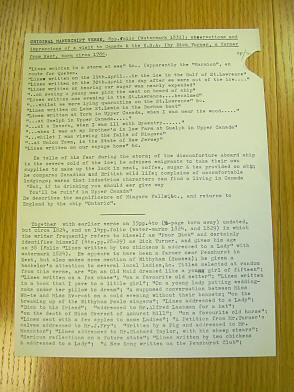
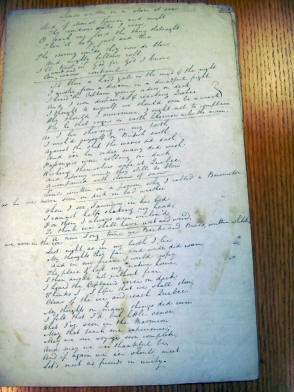
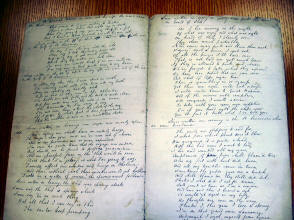
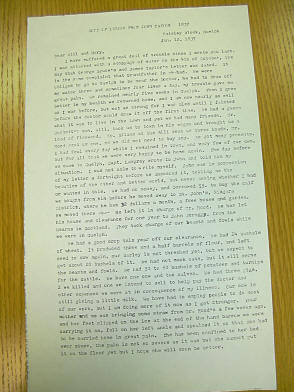
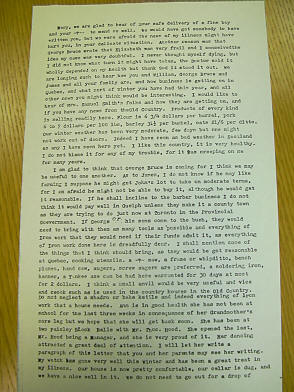
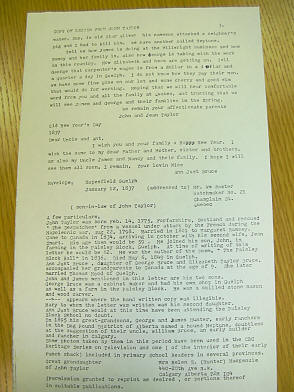
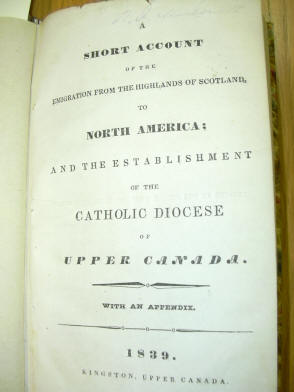
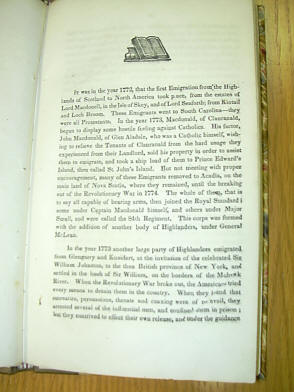
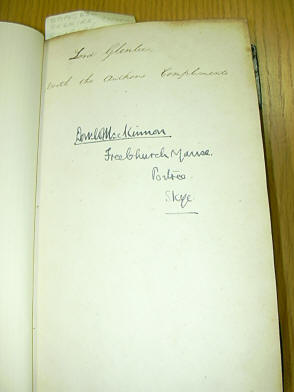
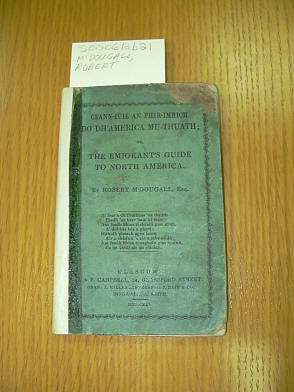
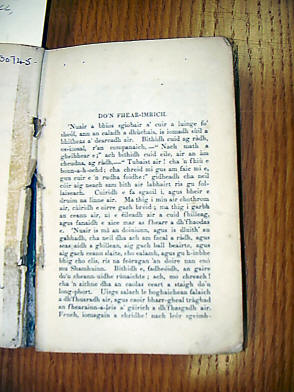
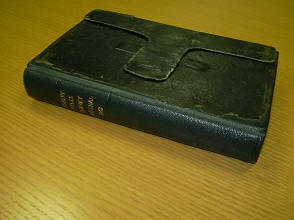
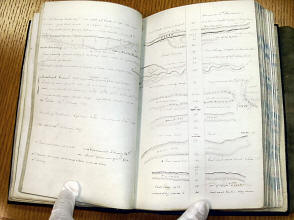
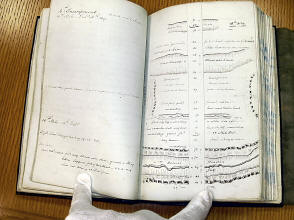
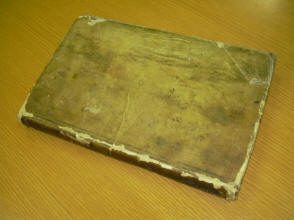
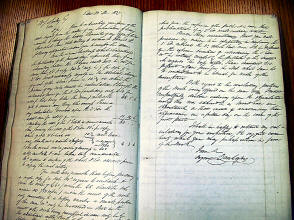
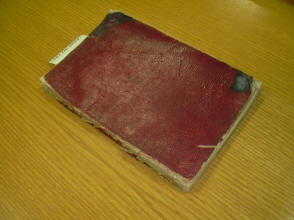
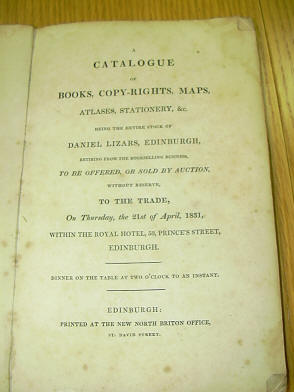
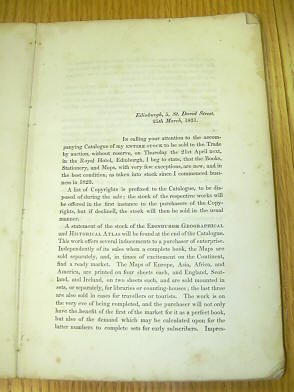
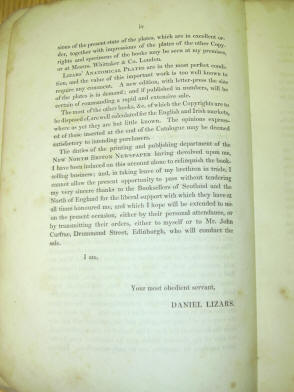
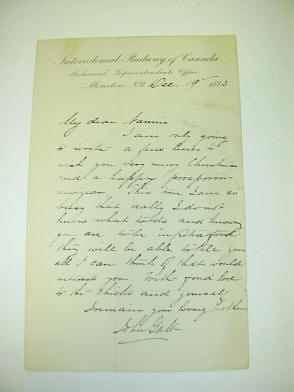
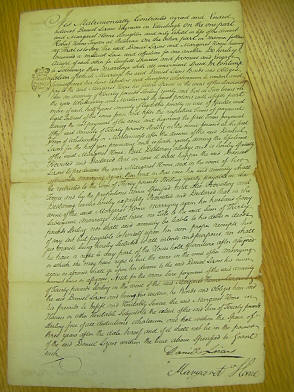
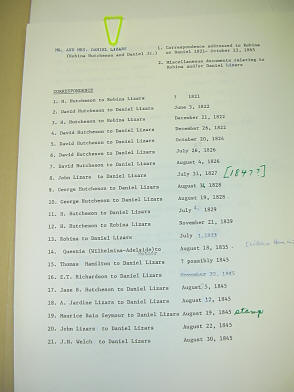
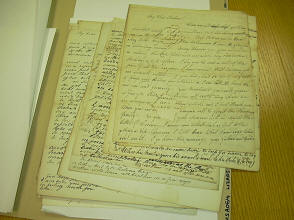
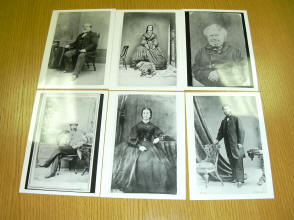
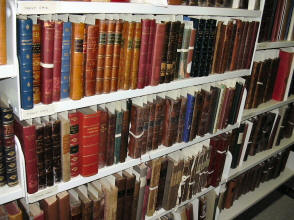
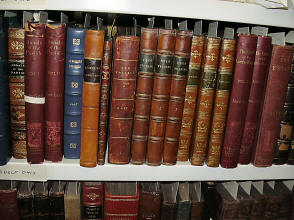
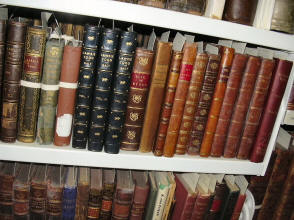
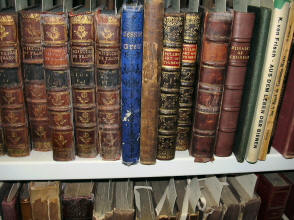
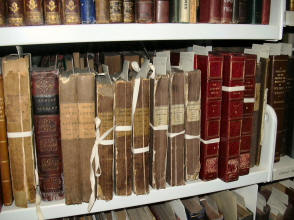
And the above is the John Galt collection which
is held in the Rare Books Collection
You can read some of John Galt's books online.
LAWRIE TODD
Or the Settlers in the Woods
Volume 1 |
Volume 2 |
Volume 3 |
